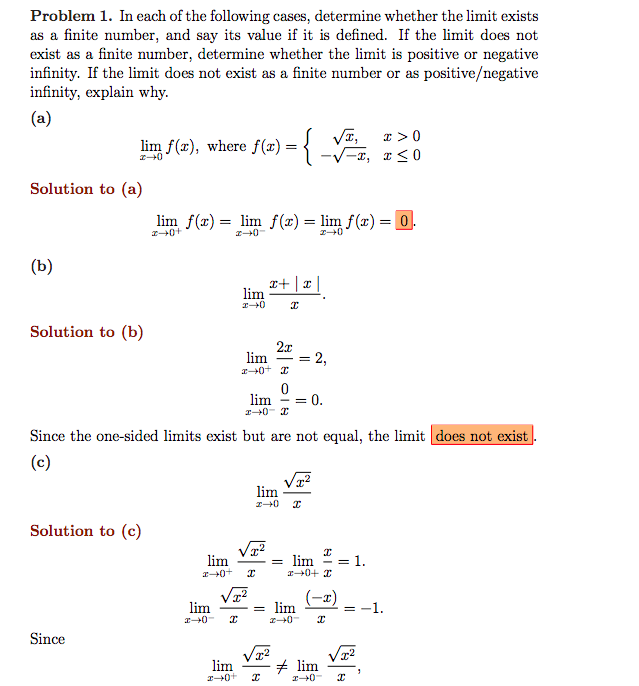Problem 1. In each of the following cases, determine whether the limit exists as a finite number, and say its value if it is defined. If the limit does not exist as a finite number, determine whether the limit is positive or negative infinity. If the limit does not exist as a finite number or as positive/negative infinity, explain why. (a) VI, I>0 -1, I<0 lim f(x), where f(r) = Solution to (a) lim f(z) = lim f(1) = lim f(x) = o. (b) I+ | 1|| lim Solution to (b) 2x lim 2, Z0+ I lim 0. z+0- I Since the one-sided limits exist but are not equal, the limit does not exist . (c) lim Solution to (c) = lim =1. I+0+ I lim (-1) = -1. lim lim Since lim # lim
Problem 1. In each of the following cases, determine whether the limit exists as a finite number, and say its value if it is defined. If the limit does not exist as a finite number, determine whether the limit is positive or negative infinity. If the limit does not exist as a finite number or as positive/negative infinity, explain why. (a) VI, I>0 -1, I<0 lim f(x), where f(r) = Solution to (a) lim f(z) = lim f(1) = lim f(x) = o. (b) I+ | 1|| lim Solution to (b) 2x lim 2, Z0+ I lim 0. z+0- I Since the one-sided limits exist but are not equal, the limit does not exist . (c) lim Solution to (c) = lim =1. I+0+ I lim (-1) = -1. lim lim Since lim # lim
Calculus: Early Transcendentals
8th Edition
ISBN:9781285741550
Author:James Stewart
Publisher:James Stewart
Chapter1: Functions And Models
Section: Chapter Questions
Problem 1RCC: (a) What is a function? What are its domain and range? (b) What is the graph of a function? (c) How...
Related questions
Question
Please explain these solutions

Transcribed Image Text:Problem 1. In each of the following cases, determine whether the limit exists
as a finite number, and say its value if it is defined. If the limit does not
exist as a finite number, determine whether the limit is positive or negative
infinity. If the limit does not exist as a finite number or as positive/negative
infinity, explain why.
(a)
lim f(x), where f(x) = {
VI, * >0
-x, x<0
Solution to (a)
lim f(x) = lim f(x) = lim f(x) = 0.
(b)
lim
Solution to (b)
2x
lim
2,
%3D
lim
= 0.
20- I
Since the one-sided limits exist but are not equal, the limit does not exist.
(c)
lim
Solution to (c)
lim
= lim
I0+ I
= 1.
(-x)
lim
lim
Since
lim
# lim
Expert Solution
This question has been solved!
Explore an expertly crafted, step-by-step solution for a thorough understanding of key concepts.
This is a popular solution!
Trending now
This is a popular solution!
Step by step
Solved in 4 steps with 3 images

Recommended textbooks for you

Calculus: Early Transcendentals
Calculus
ISBN:
9781285741550
Author:
James Stewart
Publisher:
Cengage Learning

Thomas' Calculus (14th Edition)
Calculus
ISBN:
9780134438986
Author:
Joel R. Hass, Christopher E. Heil, Maurice D. Weir
Publisher:
PEARSON

Calculus: Early Transcendentals (3rd Edition)
Calculus
ISBN:
9780134763644
Author:
William L. Briggs, Lyle Cochran, Bernard Gillett, Eric Schulz
Publisher:
PEARSON

Calculus: Early Transcendentals
Calculus
ISBN:
9781285741550
Author:
James Stewart
Publisher:
Cengage Learning

Thomas' Calculus (14th Edition)
Calculus
ISBN:
9780134438986
Author:
Joel R. Hass, Christopher E. Heil, Maurice D. Weir
Publisher:
PEARSON

Calculus: Early Transcendentals (3rd Edition)
Calculus
ISBN:
9780134763644
Author:
William L. Briggs, Lyle Cochran, Bernard Gillett, Eric Schulz
Publisher:
PEARSON

Calculus: Early Transcendentals
Calculus
ISBN:
9781319050740
Author:
Jon Rogawski, Colin Adams, Robert Franzosa
Publisher:
W. H. Freeman


Calculus: Early Transcendental Functions
Calculus
ISBN:
9781337552516
Author:
Ron Larson, Bruce H. Edwards
Publisher:
Cengage Learning